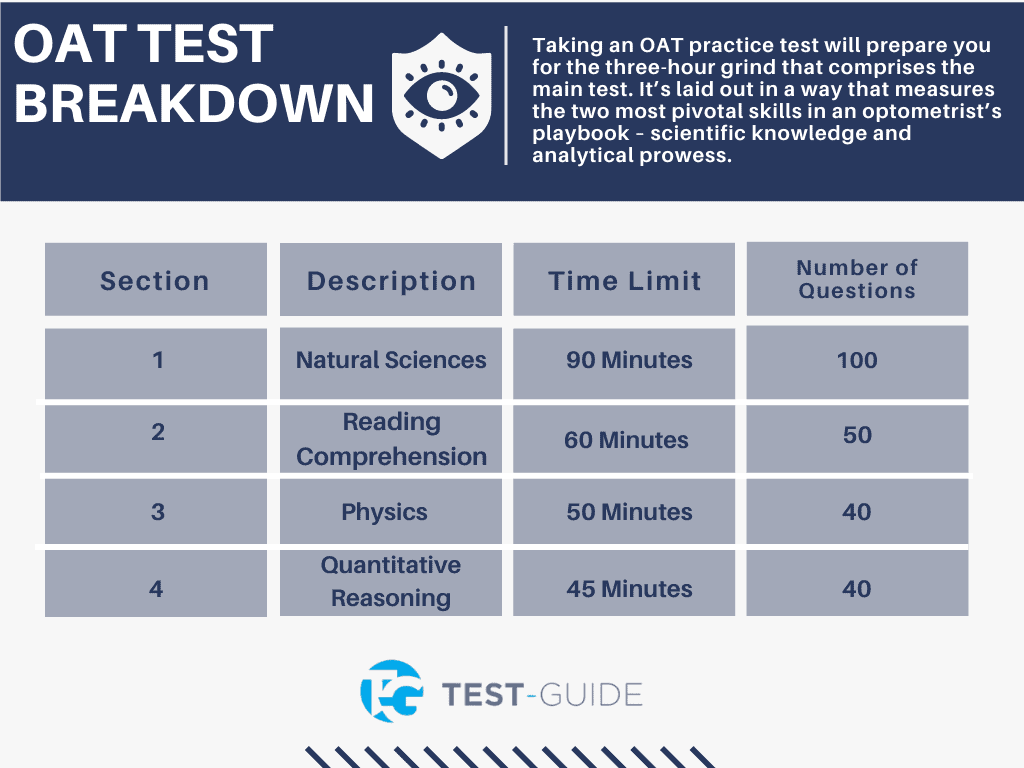The Optometry Admission Test (OAT) is a grueling six-part test that is built around important optometry skills. It is taken by candidates who wish to get into optometry school.
What makes this test so difficult is the scope of materials that are covered. An individual’s knowledge of math, reading, science, and physics are all put to the ultimate test.
It can be quite overwhelming to the unprepared so we’ve prepared a ton of study resources including free OAT practice tests.
Proper preparation for the OAT test will help you maximize your score and achieve the best results. While it’s not the only factor, understanding the test itself will put you in a much better position.
The truth is that if you want a career in the optometry field, then you have to pass this test. With that said, the minimum requirement to take the OAT exam is one year in college but we highly recommend two years to put you in the best position!
Summary: Try one of the free OAT practice tests or other study resources below to prepare for the OAT test.
OAT Practice Tests and Other Study Resources
Here is a list of free resources including OAT practice tests, flashcards, and study guides.
Taking an OAT practice test will prepare you for the three-hour grind that comprises the main test. It’s laid out in a way that measures the two most pivotal skills in an optometrist’s playbook – scientific knowledge and analytical prowess.
| Resource | Notes | Provider |
| OAT Practice Test | Try out this sample practice test to get a better idea for questions on the OAT test. | Kill Exams |
| OAT Study Guide | A very comprehensive study guide to the OAT test. | StudyGuideZone |
| Official OAT Guide | Everything you will want to know about the OAT test in this official guide. | ADA |
| OAT Biology Flashcards | Review 100+ OAT biology flashcards. | Quizlet |
| OAT Practice Questions | Review 125+ OAT practice questions. | Quizlet |
| OAT Physics Formulas | Review 130 OAT physics formulas. | Quizlet |
OAT Test Breakdown
Let’s look at a breakdown of what you can expect from the OAT test.
| Section | Description | Time Limit | Number of Questions |
| 1 | Natural Sciences | 90 Minutes | 100 |
| 2 | Reading Comprehension | 60 Minutes | 50 |
| 3 | Physics | 50 Minutes | 40 |
| 4 | Quantitative Reasoning | 45 Minutes | 40 |
Natural Sciences Section
This section of the OAT exam is 90 minutes long and it consists of 100 questions in total that work out as follows:
- General Chemistry:30 Questions
- Organic Chemistry:30 Questions
- Biology:40 Questions
If you do the math, you’ll have less than a minute to answer each question so it’s important that you’re prepared. If you have trouble with a question, skip it and move on. Do another pass at the end to answer the more difficult questions.
This is a key test-taking strategy and lets you hit all of your strengths first so that you have more time for the difficult questions.
Reading Comprehension Section
This section of the test clocks in at just 60 minutes and will comprise three full passages that you must read. Each of these passages is followed by a series of 16-17 questions.
The total number of questions in this section will always be 50. Give yourself 20 minutes per passage, which isn’t a lot of time so you’ll need to be properly prepared.
The goal is to identify an individual’s ability to process written information and diagnose dense paragraphs of text. If you have trouble with a question, move on and then come back to it before moving onto the next passage.
Physics Section
This section gives you 50 minutes and consists of 40 questions so it’s a bit more generous than the other sections in terms of time. While that looks good on paper, these questions are a bit trickier.
Expect questions related to any of the following areas:
- Energy
- Momentum
- Vectors
- Thermodynamics
- Magnetism
- Optics
As always, follow the proper test-taking process and move on from a question if you have difficulty with it. Then answer them on your second pass. The goal is to get the easier questions out of the way first.
Quantitative Reasoning Section
This is a math-heavy section that consists of 40 questions with a 45 minute time limit. You can expect anything from simple mathematics to advanced trigonometry.
To ace this section of the OAT exam, you’ll have to master algebra, geometry, and have the ability to solve complex word problems.
You can find more information and specifics about the OAT test with this official guide from the ADA.
OAT Test Administration, Registration, and Test Dates
The OAT test is given year-round and it can take up to 8 weeks from the time you apply to the date of the test. However, several prerequisites are required including classes in biology, chemistry, and physics.
Apply online to take the test and be prepared to supply proof of your academics. The entrance fee for the OAT Test is $490.
This exam is much different than other tests you’ve taken so be sure that you properly prepare. It’s designed to determine if you have the knowledge to become a successful optometrist. So your critical thinking skills are tested much more than memorization.
Finally, the OAT test is taken on a computer. When you appear for the test, you’ll need two valid forms of identification.
Candidates who wish to apply for the test need to first obtain a personal identification number (PIN). You can register for a PIN here.
Once you have your PIN, you can apply for the OAT exam here.
OAT Exam Requirements
The test is administered to students who are attending college for optometry. As a result, the requirements for taking this exam are at least one year in the appropriate academic courses and a fee of $490.
It’s worth noting that most students don’t take this test until they have at least two years of experience in the required academic courses.
How the OAT Test Score is Determined
The scale is from 200 to 400 so 300 is the median that represents the score for 50% of individuals who have taken it. Each section of the test gets its own unique score so you need to be prepared for each of them.
Every section on the test is worth the same amount of points, as is each section. Since there are no penalties for guessing on the OAT test, you should always guess if you don’t know the answer to a question. It’s better to guess and have a 20% chance than to leave it blank.
When you get your score, you’ll be able to see what percentile you rank. There is no definition for a good score since you’ll have to meet different requirements for specific jobs.
OAT FAQs
When should I start studying for the OAT test?
Once you have finished clearing the majority of your prerequisite courses like biology, chemistry, and physics. Having academic experience in these courses makes it so much easier to study for the OAT test so you should not attempt to do so beforehand.
It’s also highly recommended that you do not study for the test while taking other courses since it will require all of your focus to pass. Since the OAT exam is available all year, most students will find that summer is the perfect time to study for it.
Register for the test at least one month in advance and then start studying for this specific test at that time.
When is the best time for me to take the OAT test?
As stated with the previous question, most students will find that summer is the best time to deal with the OAT exam since it’s likely you won’t have classes to juggle.
The summer after your junior year is the best time. You’ll likely have completed your prerequisite classes and the information will still be fresh on your mind.
Although it’s possible to take the test after your sophomore year, it’s not recommended for most students since it’s going to be more difficult. The advantage to taking it early is that you have more time to retake if your score is low.
What study method is best for the OAT?
There are a lot of resources and information that it’s impossible to touch on them all in a single section so we’ll focus on a few important points.
First and foremost, never study more than two materials at the same time. This will give you information overload and overwhelm your mind, leading to unnecessary stress.
Everyone has a unique way of studying that works best for them. Some people work better with flash cards while others work great with reading. Online tutorials are another great study method and they are readily available.
One tip that is highly encouraged is that you devote some study time to just before bed because memories formed before bed stick better than information you gather in the morning.
How many retakes do I get for the OAT test?
This depends on the school that you are testing at but one fact always remains the same. You’ll have to receive special permission to take the test more than 3 times.
Keep in mind that schools are going to look at the scores much differently. One might only look at the highest score while others will look at every score to determine your qualifications.
That makes it important to take the test as few times as possible.


